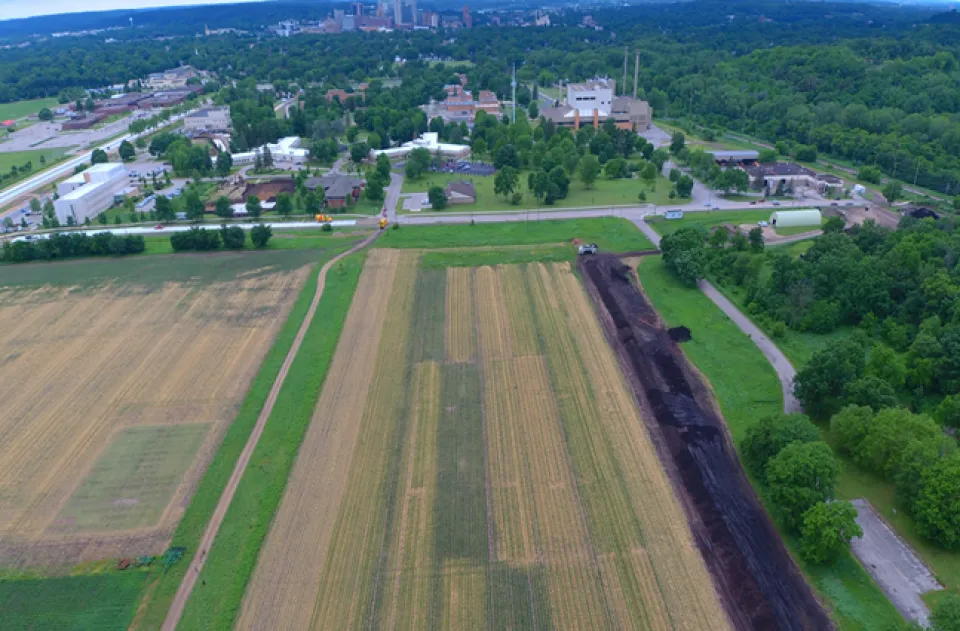Sustainable Business Park Master Plan - Turning waste into opportunity
The Sustainable Business Park is a bold new vision to transform 72 acres of vacant land into a thriving hub for green innovation. Located next to the Olmsted Waste-to-Energy Facility (OWEF) and a future state-of-the-art Materials Recovery Facility (MRF), this park will attract businesses that can use the renewable energy and materials we already produce—turning waste into economic opportunity.

What makes this park unique?
- Clean, reliable energy from the OWEF | The OWEF converts trash into steam and electricity, dramatically reducing landfill use while producing a steady supply of energy.
- High-quality recyclables from the MRF | The future materials recovery facility (MRF) will sort recyclables using advanced technology and human expertise, creating a consistent stream of materials ready for reuse.
- A closed-loop system | Businesses at the park can tap into these resources—cutting costs, maximizing the use of local resources by keeping products and materials in use, minimizing environmental impact, and supporting a circular economy.
Why it matters for Olmsted County
The sustainable business park will:
- Generate new revenue by selling energy and turning your discarded materials into valuable resources, creating new
products.
- Expand the tax base by developing underused land near the county campus.
- Attract innovative businesses that create jobs and align with our sustainability goals.
- Support residents by reducing environmental impact and boosting the local economy.
Project Goal: Master plan for a thriving Sustainable Business Park
The primary goal of this project is to develop a comprehensive master plan that prepares the Sustainable Business Park for future development. This plan will:
- Identify industries and businesses that can best utilize the energy and materials from the OWEF and MRF
- Ensure compatibility with surrounding land uses
- Lay the groundwork for infrastructure, zoning, and environmental considerations
- Guide future investment and development decisions
This master plan is a critical first step in turning vision into action—ensuring that the park is thoughtfully designed to attract the right partners and deliver long-term value to Olmsted County.
Phase 1: The What Phase
- Conducting a comprehensive analysis of the current site conditions from both land use and energy assessment perspectives.
-
Studying successful circular economy projects and industry best practices.
-
Engaging with residents and stakeholders to collect community feedback and with the Steering Committee to establish project goals and objectives.
-
Collaborating with industry leaders to define the key attributes that would attract high-value industries best positioned to benefit from proximity to the MRF and OWEF.
-
Developing a draft Vision and Existing Conditions Report.
Phase 2: The What Phase
-
Collaborating with the Steering Committee to develop and refine two concept alternatives into a preferred plan.
-
Creating visual representations for each concept
-
Continuing public outreach efforts
-
Contacting stakeholders and potential tenants for feedback, Providing status updates to the Committee of the Whole
-
Developing the draft Master Plan.
Phase 3: The How Phase
-
Identifying project priorities, estimating costs, ensuring regulatory compliance, and addressing local regulation changes.
-
Exploring funding opportunities and creating marketing and educational resources.
-
Seeking feedback on the draft plan through public engagement efforts.
-
Revising the draft to finalize the Master Plan.
-
Implementing strategies to preparing the land for marketing and development.
The final master plan will include:
- Two concept alternatives
- A preferred concept plan
- Design guidelines
- Recommendations for infrastructure and transportation investments
Exploring Potential Land Uses
Currently, Olmsted County and their Consultant Team at Short Elliott Hendrickson ® (SEH) are exploring potential land uses. Primary and secondary land uses describe the types of businesses and activities that could locate in the Sustainable Business Park. Primary uses are the core industries that directly benefit from the energy and materials produced by the OWEF and MRF. Secondary uses support or complement those industries—such as offices or services that enhance the park’s functionality and community value.
Potential Primary Land Uses:
- Modern industrial manufacturing
- Technology driven industry
- Educational or material research and development
- Industrial greenhouse

Potential Secondary Land Uses:
- Rooftop solar farms
- Office Space
- Brewery/Distillery
- Public Park, Greenspace, Trials and other placemaking elements
The team is also collaborating with target industries to identify key attributes that would attract high-value industries best positioned to benefit from proximity to the MRF and OWEF.
What's Next?
A draft Vision and Existing Conditions Report, along with an Energy Assessment Abilities and Options Report—providing a thorough evaluation of current site conditions from both land use and energy assessment perspectives—is expected to be completed in Winter 2025.
Additional Links
Olmsted County General Land Use Plan
Olmsted County General Land Use Plan – 2045 StoryMaps
